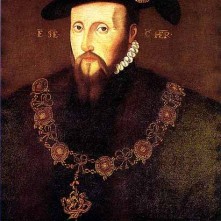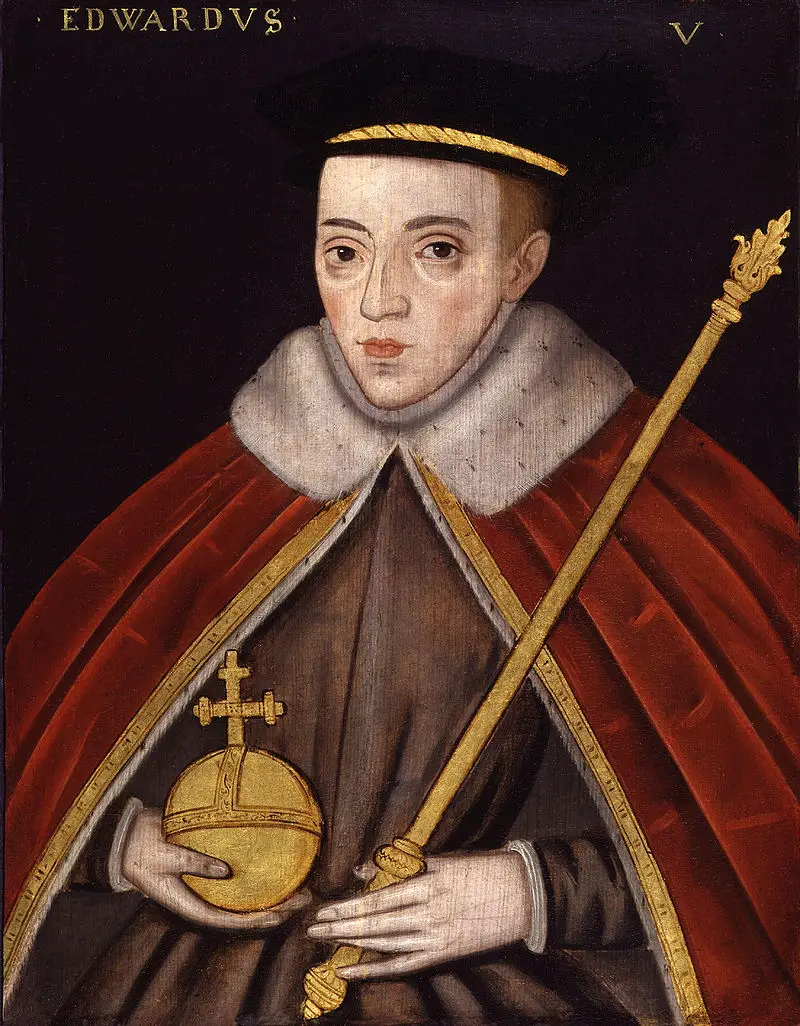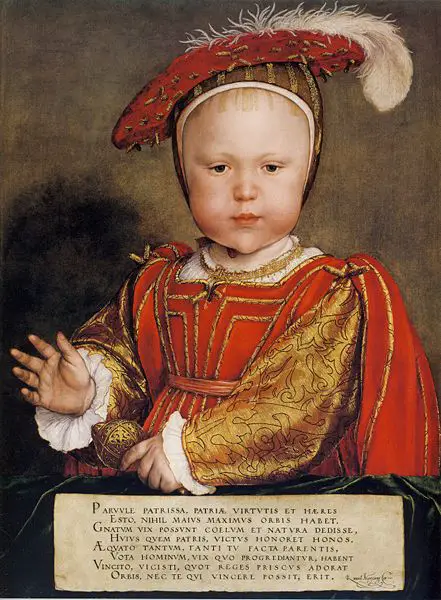12 October
1537 - Birth of Edward VI, son of Henry VIII and Jane Seymour, at Hampton Court Palace.1555 – Birth of Peregrine Bertie, 13th Baron Willoughby of Willoughby, Beck, and Eresby, at Wesel in Cleves. Bertie was the son of Richard Bertie and his wife, Katherine (née Willoughby), Duchess of Suffolk and widow of Charles Brandon, Duke of Suffolk. Bertie was born while his Protestant parents were in exile during Mary I's reign.
1555 – Assassination of Lewis Owen, member of Parliament and administrator in Wales, on Dugoed Mawddwy, a mountain pass. He had become unpopular after supporting new legislation in Wales, and his assassination is viewed as revenge for his campaign, with John Wyn ap Meredydd of Gwydir, against outlaws. It had resulted in around eighty hangings.
1598 – Death of Thomas Stapleton, Roman Catholic theologian, at Louvain. He was buried there, at St Peter's Church. Stapleton's works included translations, commentaries on parts of the Bible and anti-Calvinist treatises such as Antidota.
1616 – Death of Henry Cavendish, soldier and son of Sir William Cavendish and his third wife Elizabeth (Bess of Hardwick). He was buried at Edensor in Derbyshire.
13 October
1499 - Birth of Queen Claude of France, wife of Francis I, in Romorantin-Lanthenay. She was the eldest daughter of Louis XII of France and Anne of Brittany.1534 – Alessandro Farnese became Pope Paul III.
1549 – The Council abolished Edward Seymour, Duke of Somerset’s Protectorate, and his membership of the Council.
1579 – Death of Sir William Drury, soldier and Lord Justice of Ireland, at Waterford, during Desmond's Rebellion. He was buried in Dublin, at St Patrick's Cathedral.
1591 – Death of Sir Edward Waterhouse, administrator, at his estate, Woodchurch in Kent. Waterhouse served Elizabeth as Chancellor of the Exchequer and of the Green Wax in Ireland from October 1586 to October 1589.
14 October
1536 – Pilgrimage of Grace. By 14th October the uprising in the north had turned into a proper rebellion. On 13th October, Lord Darcy had reported to Henry VIII that the East Riding, West Riding, North Riding and “all the commons of Yorkshire” were “up” in rebellion, and on 14th October William Haryngton, Mayor of York, and Sir George Lawson, wrote to the King asking for aid because “the commons… have rebelliously assembled to take York”.1559 – Death of John Williams, Baron Williams and Lord President of the Council in the Marches of Wales, at Ludlow Castle. He was buried in Thame Church.
1565 – Statesman and poet, Thomas Chaloner, died at his home in Clerkenwell, London. During the reign of Elizabeth I he acted as the English ambassador to Ferdinand I, Holy Roman Emperor, in 1558, and then ambassador to Philip II in the Low Countries, and then Spain between 1559 and 1561. Chaloner was a great friend of William Cecil, Lord Burghley. In 1564, his health began to fail, and he was allowed to return home. He died there on the 14th October 1565, aged forty-four.
1586 - The trial of Mary, Queen of Scots began at Fotheringhay Castle in Northamptonshire. Sentence was delayed as long as possible, by order of Elizabeth, but on the 25th October the commission reconvened and found Mary guilty. On the 8th February 1587 Mary, Queen of Scots was executed at Fotheringhay Castle.
1593 – Death of Arthur Grey, 14th Baron Grey of Wilton, soldier and Lord Deputy of Ireland, at his home of Whaddon in Buckinghamshire. He was buried there. Grey had a reputation for radical Protestantism.
1596 – Death of John Coldwell, Bishop of Salisbury, at Salisbury. He was buried in the cathedral, in the grave of Bishop Wyvil due to his state of poverty.
15 October
1536 – Henry VIII wrote to the Earl of Shrewsbury, the Duke of Suffolk “and others” with instructions on handling the rebellion which we now know as the Pilgrimage of Grace. The King also wrote to the rebels in Lincolnshire promising “to show them mercy if they leave all their harness and weapons in the market-place of Lincoln”.1537 - Christening of Henry VIII’s son, the future Edward VI, in the Chapel Royal at Hampton Court. Edward’s half-sister Mary stood as godmother, while his other half-sister, the four year-old Elizabeth, bore the chrisom cloth, helped by Edward’s uncle, Edward Seymour. Thomas Howard, the Duke of Norfolk, Charles Brandon, the Duke of Suffolk, and Archbishop Cranmer stood as godfathers.
1542 – Death of William Fitzwilliam, Earl of Southampton, courtier, diplomat and naval commander, in Newcastle-upon-Tyne. It is thought that he was buried in Newcastle. Southampton's offices included Vice Admiral, Treasurer of the Household and Lord Privy Seal. He died while leading troops to Scotland under the command of Thomas Howard, 3rd Duke of Norfolk.
1582 – The first day of the Gregorian calendar following the last day of the Julian calendar, 4th October 1582, meaning that the 5th-14th October did not exist in the year 1582. Many countries ignored Pope Gregory XIII’s papal bull and carried on using the Julian Calendar. England, for example, did not introduce the Gregorian calendar until 1752.
1584 – Execution of Richard Gwyn (White), martyr, schoolteacher and Welsh language poet, at Wrexham in Wales. He was hanged, drawn and quartered for high treason because of his Catholic faith.
1590 – Death of William Bleddyn (Blethin), Bishop of Llandaff. He was buried in Matharn Church, in the chancel.
1595 – Death of Philip Howard, 13th Earl of Arundel, in the Tower of London. It was rumoured that his cook had poisoned him. Arundel had been imprisoned for high treason, because of his Catholic faith and for fleeing England without Elizabeth I's permission. He was buried in the Tower chapel, St Peter ad Vincula.
16 October
1555 - The burnings of two of the Oxford martyrs: Hugh Latimer, Bishop of Worcester, and Nicholas Ridley, Bishop of London. The two men, along with Thomas Cranmer, who was burnt at the stake on the 21st March 1556, are known as the Oxford Martyrs and their lives and deaths are commemorated in Oxford by Martyr’s Memorial, a stone monument just outside Balliol College and near to the execution site, which was completed in 1843. Foxe wrote of their deaths:-“Thus did these two pious divines and stedfast believers, testify with their blood the truth of the everlasting gospel, upon which depends all the sinners’ hopes of salvation; to suffer for which was the joy, the glory of many eminent Christians, who having followed their dear Lord and Master though much tribulation in this vale of tears, will be glorified for ever with him, in the kingdom of his father and our father, of his God and our God.”
1573 – Death of Thomas Davies, Bishop of St Asaph, at Abergele in Denighshire.
1594 – Death of Cardinal William Allen at his home in the via Monserrato, Rome, while in exile. He was buried in Rome, in the English College's Church.
17 October
1560 – Baptism of Walter Marsh, spy and Protestant martyr, at St Stephen's Church, Coleman Street, London. Marsh was burned to death in Rome’s Campo dei Fiori after having his tongue and hands cut off. He had been accused of being paid by Elizabeth I to spy on Catholics and showing contempt for the Eucharist.1586 - The poet, courtier and soldier Sir Philip Sidney died as a result of an injury inflicted by the Spanish forces at the Battle of Zutphen in the Netherlands. His body was returned to England and laid to rest on the 16th February 1587 in St Paul’s Cathedral.
1592 – Death of Frances Brooke, Lady Cobham, wife of William Brooke, 10th Baron Cobham. She was buried at Cobham. Lady Cobham is known for being featured in the famous Elizabethan family portrait, The Cobham Family (1567). She served Elizabeth I as Mistress of the Robes and Lady of the Bedchamber.
1595 – Death of Sir Thomas Heneage, courtier and politician, at the Savoy. He was buried at St Paul's Cathedral, in the Lady Chapel. Heneage served Elizabeth I as a member of Parliament, gentleman of the Privy Chamber, Vice-Chamberlain of the Household, Privy Councillor and Chancellor of the Duchy of Lancaster.
18 October
1529 – Cardinal Thomas Wolsey surrendered the Great Seal following the writ of praemunire being filed against him on the 9th October.1536 – Birth of William Lambarde, antiquary and lawyer, in London. Lambarde is known for his “Perambulation of Kent” (1570) and “Eirenarcha: or of the Office of the Justices of Peace” (1581).
1538 – Baptism of Francis Kinwelmersh (Kindlemarsh), poet, at All Hallows Church, Bread Street, London. Kinwelmersh is known for his collaboration with George Gascoigne on “Jocasta” (1566) and his contributions to “The Paradyse of Dainty Devises” (1576).
1541 - Margaret Tudor, sister of Henry VIII and former Queen of Scotland, died of a stroke at Methven Castle, Perthshire, Scotland. She was laid to rest at the Carthusian Priory of St John in Perth, which was later destroyed.
1555 – Elizabeth Tudor, the future Elizabeth I, was finally given permission to leave court and travel to her own estate at Hatfield, rather than return to house arrest at Woodstock.










Thank you for the new information. Not having that much knowledge about England’s history, it is great to now be a small part in a large bowl of royal history. I even find information about my own family named Cavendish. Thank you.
Have you done much work on your family tree?
Hi Claire,
In answer to your question, I have done quite a lot. When one day I was trying to catch up on my Ancestry.com leafs,when I was totally surprised that I was the 1st cousin 14 generations removed to Anne Boleyn. I am also still finding information on another ancestor George Cavendish who was in Henry VIII’s court. He apparently was someone maybe like a court reporter who wrote about court matters, etc. I’m not sure of his actual title, but I found the information when reading my email the other day from The Anne Boleyn Files. I am still locating other royal ancestors, of which I have been totally surprised. Thank you for asking.
Linda Monroe
Hi Linda,
It must be wonderful to be able to go so far back. I’ve got stuck with mine and Tim’s family got stuck with his too. We just keep hitting dead ends, very frustrating. George Cavendish was Cardnal Wolsey’s gentleman usher and he wrote “The Life of Cardinal Wolsey” about his beloved master – see https://archive.org/details/lifeofcardinal00cave.
Claire,
First, thank you for the information about George Cavendish. It is greatly appreciated.
Next, do not give up on our ancestry, even if you do not have anything right now. The only suggestion I might make is to locate any ancestry booklets someone else has prepared. On both sides of my family, there was a relative who put something together. On my father’s side is German, from the north west corner of Germany. Most of relatives came from Oldenburg, which is on the side where the North Sea comes in. When the family came over, at some point the name was changed from Juelfs to Johnson. It is much more extensive on my mother’s side, the family is Edgerton (original “Egerton”). Just keep looking and before long you will have more information.
Thank you! I’ve put it on hold for now (not enough hours in the day) and perhaps when I next go back to it I’ll be able to find more information.